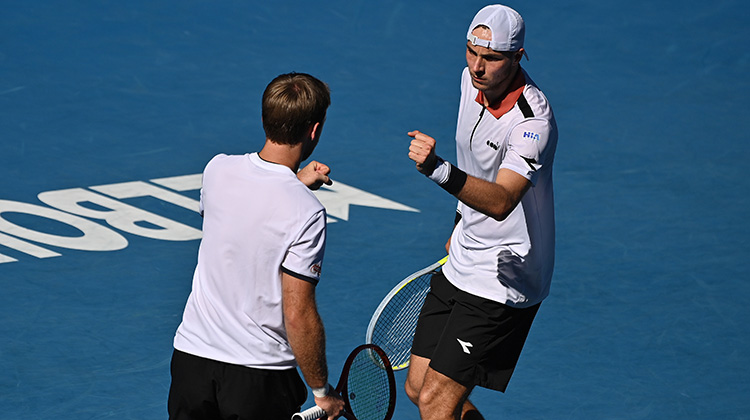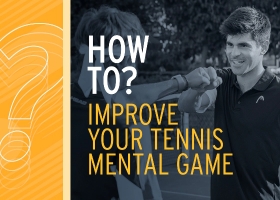How to play Tennis Doubles
Navigation:
- Tennis doubles positioning
- Tennis doubles strategy
- How to speak to your doubles partner
- Tennis doubles rules
- How long is a tennis doubles match?
While tennis is an individual sport, that’s only half the story. For many people, tennis is a team game, played with a partner alongside you. To help you have fun, and perhaps even some success on the doubles court, here are some tips on positioning, strategy and how to talk to your partner, as well as a look at the rules.
Tennis doubles positioning:
Traditionalists will tell you that you should get to the net as much as possible in doubles. But not everyone feels comfortable in the service boxes so you could start with both of you on the baseline. But if you do like playing volleys, stand as close to the net as possible, as that will allow you to dominate the service boxes.
You might choose the regular doubles formation of one at the back and one at the net. But there's an alternative you might not have previously considered. The Australian or 'I' formation will probably unsettle your opponents - they won't know what you're going to do next. This is when you stand very close to the 'T' when serving, so you're ready to cover either side, and your partner crouches in front of you in the service box, also very close to the middle of the court. The returner will have to guess where you and your partner will move to after you have served - who is going to cover which side? - and that doubt could force them into an error.
Tennis doubles strategy:
One way of creating confusion and uncertainty in your opponents' mind is crossing when using a regular doubles formation. You need to agree in advance whether you're going to make the switch. Doubles teams usually cross when serving, but you can also do it when returning. Even when you're not crossing, you can 'fake' a cross, making the other team think you're about to move - they will be even more unsure of what's happening and where they should play the ball.
Keep changing it up. Use the standard doubles formation with and without crossing, and also play some points with the Australian formation.


On the doubles court, there's more opportunity to play to your strengths and to cover your weaknesses. Let's say your forehand is more of a weapon than your backhand. Choose to receive from the advantage court (this is assuming you’re right-handed so the reverse is true if you’re a lefty). And when you're serving, you can ensure you play more forehands - when you're serving from the advantage court, stand very close to the 'T' and immediately move to the right and into the deuce court after serving. Your partner will already be on your left, ready to cover the advantage court.
If you're not very comfortable at net, that doesn't matter as much in doubles as in singles as you can rely on your partner to hit most of the volleys.
While playing to your own strengths, you should also be looking to exploit your opponents' weaknesses, and stop them from using their strengths.
How to speak to your tennis doubles partner:
Try to be as positive as possible, with plenty of praise and encouragement, even if that sometimes means faking that positivity. If you start blaming your partner when things are going wrong, and they also start sniping at you, it's not going to help you play your best tennis. It also won’t be much fun.
When you're discussing strategies and tactics, make sure it's clear who is doing what. The last thing you want to do is to confuse each other.
Never order your partner around - you should be working together as a team.
If you can speak openly about your strengths and weaknesses, that will help you to decide on the formations and strategies that suit you as a team and give you the best chance of winning a match.
After a disappointing defeat, it probably helps to speak about the match soon after leaving the court. That will stop any resentment from building and also help you to learn from the loss.
Tennis doubles rules:
The court is expanded to include the tramlines.
The no-ad rule is often used in professional doubles and you could try it too as it often makes for quicker and more exciting matches. That means sudden death at deuce – whichever team wins the next point wins the game. The receiving team get to choose whether the server serves to the deuce or advantage side.
Instead of a regular third set in a best-of-three-set match, you could play a champions tie-break, which is won by the first team to 10 points (you have to be ahead by at least two points).
The serve rotates, so each player gets to serve once every four games. Decide between you and your partner who serves first – most teams would start with the strongest player.
You can change the order in which you and your partner serve, but only at the beginning of a set.
You and your partner can also switch sides when receiving, but again you can only make that change at the start of a set.
How long is a tennis doubles match?
Like a singles match, it entirely depends what format you play - you could choose to play just one set, which will probably take between 30 and 60 minutes, or if you have more time you could opt to play a best-of-three-sets match, whether with a regular third set or a champions tie-break.

















